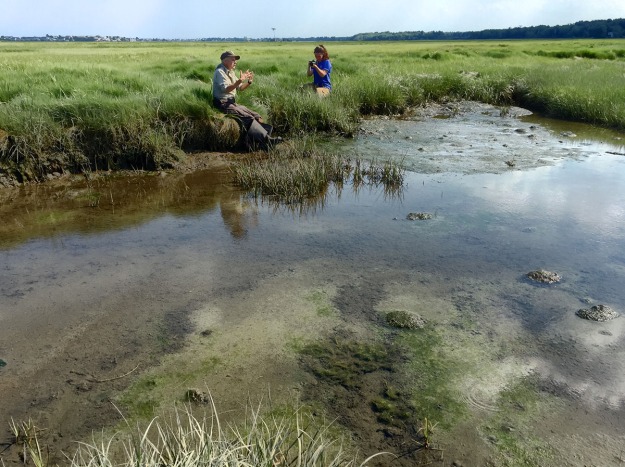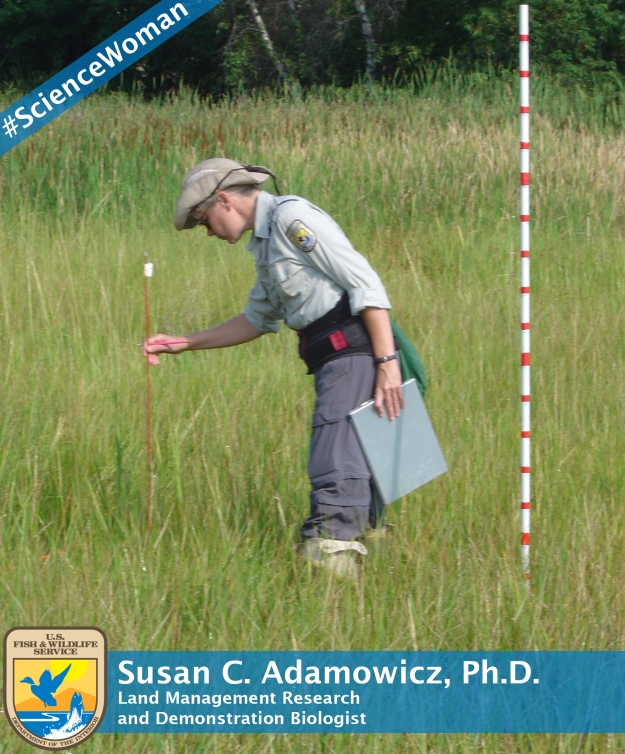
Dr. Susan Adamowicz is standing on a salt marsh along the shores of the Webhannet River at Rachel Carson National Wildlife Refuge in Maine. This refuge is practically her home, where she has worked for the past 13 years as a land management and research demonstration biologist for the Service.
Coastal marshes are a habitat she has known and loved since she was a child. But today, salt marshes are facing new and unprecedented threats from climate change. We asked her to talk to us about the important role salt marshes play in protecting coastlines and building coastal resiliency.
Q: What are salt marshes and what makes them important?
Susan: Salt marshes are exciting places to work! They are dynamic areas. Salt marshes form where rivers meet the sea and where the velocity of water is slow enough to allow the sediment to deposit and for plants to take root. Over time, as salt marshes continue to grow, they rise in elevation and expand outward horizontally.
They support a wide variety of wildlife that’s specialized to live in this salty, tidal environment, everything from micro biota to birds such as the saltmarsh sparrow to numerous species of mammals and fish. They also provide environmental services, such as storing carbon, filtering water and providing natural defenses against storms by buffering the force of both storm surges and storm waves.
Q: Let’s talk about storms—how did Hurricane Sandy change the way we think about protecting coastal communities?
Susan: The coast was forever changed, as was our perception of what it means to live along the coast. We saw the tremendously destructive force of what nature can do, but we also saw how this force can be lessened by having salt marshes in place to protect our shores.
After Hurricane Sandy, I think many of us woke up to the challenge of having to think about our coastal systems in new ways. How might we redesign our coasts so that in some areas we could restore the natural systems, like salt marshes, that can provide more natural flexibility and protection from storm surge, big storm waves or even additional rainfall?
Q: How do we prepare for future storms and sea-level rise and stay resilient?
Susan: Salt marshes play a vital role in the resiliency of coastal systems. Imagine if this salt marsh was not here. There would be no buffer from the turbulence of storms. And because healthy salt marshes can grow higher in elevation, they can provide a continuing protection to human communities if sea levels don’t rise too high too quickly. By being able to handle the force of storms and recover quickly, we say that salt marshes are resilient and they pass this protection on to surrounding human communities.
We’re also using all kinds of new techniques to restore coastal marshes and improve resiliency. Thin-layer deposition is one example. It uses clean dredge sediments to build up the marsh surface elevation to a height that’s optimal for the salt marsh grasses to continue to build the marsh on their own over time. We have several thin-layer deposition projects on national wildlife refuges as a result of Hurricane Sandy funds [for example, at John Chafee National Wildlife Refuge in Rhode Island and Edwin B. Forsythe National Wildlife Refuge in New Jersey].

Susan Adamowicz shows interns how to take salt marsh elevation samples. Credit: USFWS
Q: You’ve worked in coastal marshes for a long time—how has your work changed and what do you see for the future?
Susan: A lot has changed. We no longer talk about restoring a salt marsh to the configuration it had in the 1600s. Now we talk about restoring the trajectories of salt marsh-building forces so that a salt marsh can sustain itself and have a high degree of integrity over time.
With super storms, climate change and their effects, we’re seeing unprecedented forces placed on the coast.
It’s like Godzilla is walking all over our picnic and we are trying to figure out how best to prepare ourselves, how best to respond to this climate change Godzilla. I may be exaggerating a little bit, but maybe only a little bit because it has been such a challenge to us.
Some of the models predict that our coastlines are going to be entirely changed by sea-level rise in the next 100 years and I worry a great deal about the kind of planet that my nieces and nephews and their children will inherit.
I take hope in realizing it is not just me alone, but within the family of the U.S. Fish and Wildlife Service and my family of other professional scientists, there are a lot of us that are concerned about the same thing. We want to pass on a healthy planet to future generations. If we can bring these salt marshes 50-75 years into the future, I think we will have done a service for the next generation of scientists, wildlife lovers and folks that live on the coast, a service that they can then build on.
Reprinted from Fish and Wildlife News, Fall 2016, p. 18-19

Susan Adamowicz along the Webhannet River at Rachel Carson National Wildlife Refuge in Maine. Credit: USFWS










